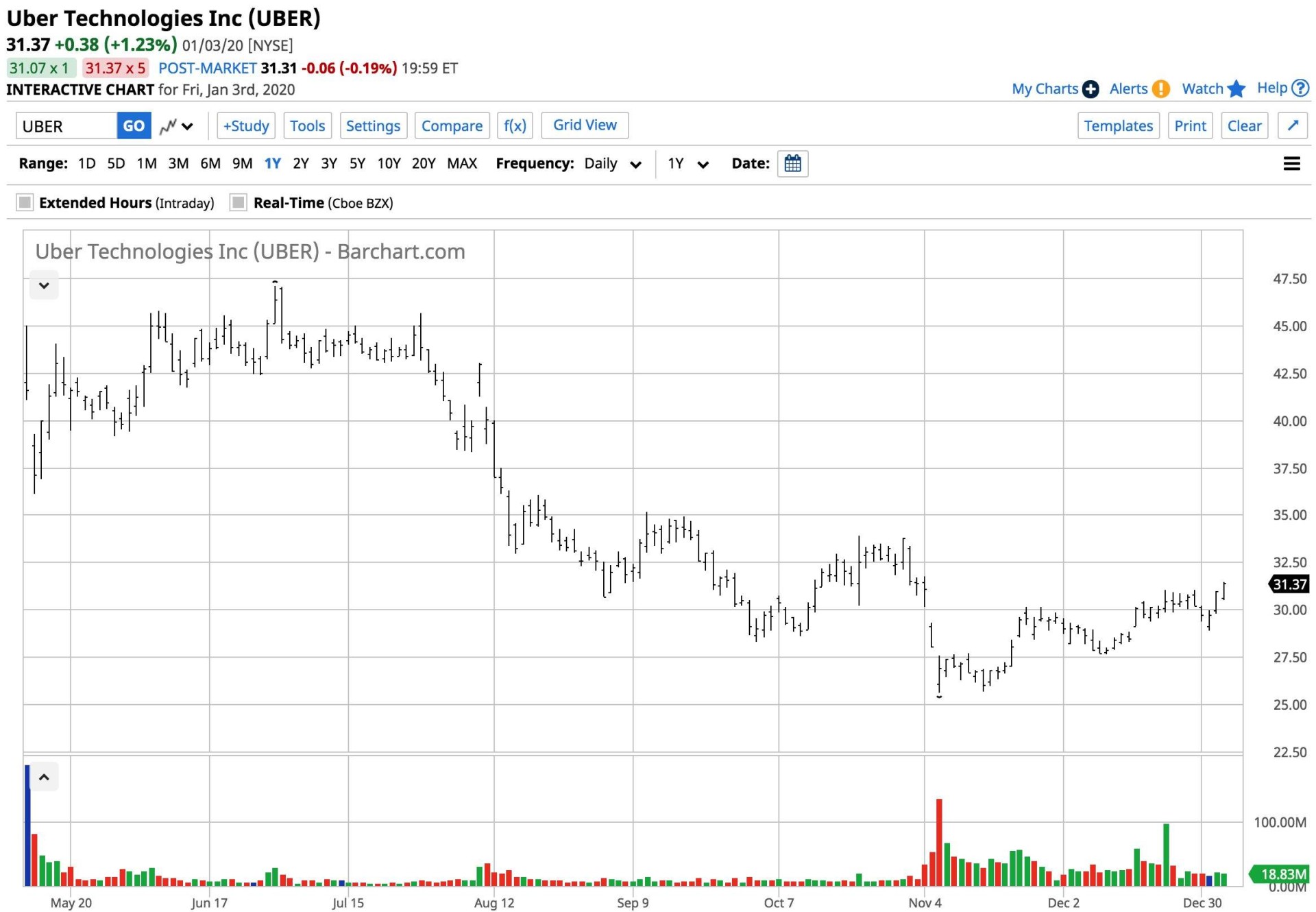2019 was a banner year for the stock market. The Dow Jones Industrial Average gained over 22% for the year. The S&P 500 did even better, with an almost 29% rise from the end of 2018. The tech-heavy NASDAQ was the winner, with an incredible 35% gain in 2019. It was hard to lose money in investment portfolios in 2019.
Meanwhile, two of the most high-profile initial public offerings of the year went sour as Uber and Lyft moved significantly lower from their opening levels on the first issue day. At the same time, another company that was getting ready to go public, WeWork, saw its plans go up in smoke.
The action in the highest-profile IPOs of 2019 was a warning that anything with a ticker symbol is not guaranteed success.
LYFT was a downer
In late March 2019, LYFT went public at an IPO price of $72 per share. The company sold 32.5 million shares at the IPO level.

(Source: Barchart)
The chart shows that while shares of LYFT traded above the IPO price to a high at $88.60 on March 29, it was all downhill for the stock throughout 2019. On December 31, LYFT closed at $43.02 per share, less than half the price at the high and 40.25% below its IPO price. The shares were at the $43.19 level last Friday.
According to Yahoo Finance a survey of 34 analysts believe the target on LYFT shares is from $35 to $96.50 with an average of $67.49. A higher level for the stock in 2020 will depend on an improvement in earnings. In Q3, LYFT beat consensus estimates, but the company still lost $1.57 per share. I would be a buyer of LYFT on price weakness with a tight stop looking to re-enter at lower lows in the hope of catching a move on the upside. The company said it expects to turn an operating profit by Q4 2021, which is a long way down the road.
UBER was just as bad
Uber followed LYFT into the IPO market. On May 9, 2019, UBER’s IPO was at $45 per share, and the company raised a total of $8.1 billion.

(Source: Barchart)
The chart shows that the performance on the days following the IPO was weak as the shares fell to a low at $36.08. On June 28, UBER struggled to rise above its IPO price when the stock reached $47.08, but it fell like a stone from August through November, even as the overall stock market moved higher. On December 31, UBER closed 2019 at $29.74 per share, 33.9% lower than the IPO price.
An average of 34 analysts have a range of price targets for UBER shares of $26 to $62 per share. Like LYFT, UBER beat consensus earnings estimates in Q3 2019, but reported a 65 cents per share loss. I prefer UBER to LYFT when it comes to a longer-term investment as the company’s larger market cap of $54 affords it more economies of scale on the path to profitability. I would be a buyer of UBER shares at the current price level and would add on a on a scale-down basis in 2020.
The WeWork was a disaster
2019 was an excellent year for the stock market, but not for those high-profile IPOs that the market tends to salivate over. The performance of LYFT and UBER was bad enough, but another anticipated IPO never even made it to market.
Valuation and management problems at WeWork, a company that leases office space long-term and rents it out short-term, caused the shareholders and company to cancel its plans for a public offering. At the same time, the founder and CEO, Adam Neumann, was asked to leave the company because of the problems. While many workers at the company lost their jobs, Mr. Neumann walked away with a reported $1.7 billion risk-free payoff from SoftBank as they took over the ailing company.
2019 may have been a year where investors saw their portfolio values soar. However, anyone who bought the LYFT or UBER IPOs or those employees that dreamed of incredible riches from their WeWork shares were big losers in a year where buying any index fund would have been a far more profitable choice.
WeWork will eventually come to market at a significantly lower valuation than 2019 expectations. LYFT needs to show the market it can be a profitable company in 2020, and UBER, in my humble opinion, has the best chance for a surprise on the upside.
LYFT shares were trading at $43.19 per share on Monday afternoon, down $0.00 (0.00%). Year-to-date, LYFT has gained 0.40%, versus a 0.28% rise in the benchmark S&P 500 index during the same period.
About the Author: Andrew Hecht

Andy spent nearly 35 years on Wall Street and is a sought-after commodity and futures trader, an options expert and analyst. In addition to working with StockNews, he is a top ranked author on Seeking Alpha. Learn more about Andy’s background, along with links to his most recent articles. More...
More Resources for the Stocks in this Article
| Ticker | POWR Rating | Industry Rank | Rank in Industry |
| LYFT | Get Rating | Get Rating | Get Rating |
| UBER | Get Rating | Get Rating | Get Rating |






